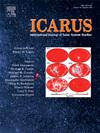Insights for hydrated sulfuric acid on Europa's surface from a combined orbital – experimental approach.
IF 2.5
2区 物理与天体物理
Q2 ASTRONOMY & ASTROPHYSICS
引用次数: 0
Abstract
Europa's non-water ice component may come from its interior ocean or from exotic processes (e.g. surface irradiation and/or impacts). We investigate these possible sources globally using all high spatial resolution (<25 km/pixel) data acquired by the Near-Infrared Mapping Spectrometer (NIMS) onboard Galileo, which is more advantageous than previous studies that only used few selected high spatial resolution datasets, or those with global coverage yet low spatial resolution. We find that the slopes of NIMS spectra from 1.3 to 2.2 μm show the same hemispheric dichotomy displayed by incident radiation fluxes, with trailing hemisphere spectral slopes being much more negative, or “bluer”, than those of the leading hemisphere. Spectral slopes are also bluer locally in older terrains, further suggesting a surface exposure-age dependence. In our examined endmember library, only sulfuric acid octahydrate (H2SO4 • 8H2O, “SAO”) can explain this blue slope. Water ice – SAO ice mixtures show blue slope strength increases with SAO abundance. We attribute the behavior of Europa's NIMS spectral slopes to indicate the likely presence of hydrated sulfuric acid. Weak blue slopes in Europa's endogenic features suggest minor SAO abundances.
从联合轨道-实验方法对木卫二表面水合硫酸的洞察。
木卫二的非水冰成分可能来自其内部海洋或外来过程(如表面辐照和/或撞击)。我们利用伽利略号上的近红外测绘光谱仪(NIMS)获取的所有高空间分辨率(25公里/像素)数据在全球范围内对这些可能的来源进行了研究,这比以前的研究更有优势,这些研究只使用少数选定的高空间分辨率数据集,或者那些覆盖全球但空间分辨率较低的数据集。我们发现NIMS光谱在1.3 ~ 2.2 μm范围内的斜率表现出与入射辐射通量相同的半球二分性,后半球的光谱斜率比前半球的光谱斜率负得多,或“更蓝”。在较老的地形中,光谱斜率在局部也更蓝,这进一步表明地表暴露与年龄有关。在我们检查的端元库中,只有八水硫酸(H2SO4•8H2O,“SAO”)可以解释这种蓝色斜率。水冰- SAO冰混合物的蓝坡强度随SAO丰度的增加而增加。我们将木卫二NIMS光谱斜率的行为归因于水合硫酸的可能存在。在木卫二的内生特征中,微弱的蓝色斜坡显示出少量的SAO丰度。
本文章由计算机程序翻译,如有差异,请以英文原文为准。
求助全文
约1分钟内获得全文
求助全文
来源期刊

Icarus
地学天文-天文与天体物理
CiteScore
6.30
自引率
18.80%
发文量
356
审稿时长
2-4 weeks
期刊介绍:
Icarus is devoted to the publication of original contributions in the field of Solar System studies. Manuscripts reporting the results of new research - observational, experimental, or theoretical - concerning the astronomy, geology, meteorology, physics, chemistry, biology, and other scientific aspects of our Solar System or extrasolar systems are welcome. The journal generally does not publish papers devoted exclusively to the Sun, the Earth, celestial mechanics, meteoritics, or astrophysics. Icarus does not publish papers that provide "improved" versions of Bode''s law, or other numerical relations, without a sound physical basis. Icarus does not publish meeting announcements or general notices. Reviews, historical papers, and manuscripts describing spacecraft instrumentation may be considered, but only with prior approval of the editor. An entire issue of the journal is occasionally devoted to a single subject, usually arising from a conference on the same topic. The language of publication is English. American or British usage is accepted, but not a mixture of these.
 求助内容:
求助内容: 应助结果提醒方式:
应助结果提醒方式:


